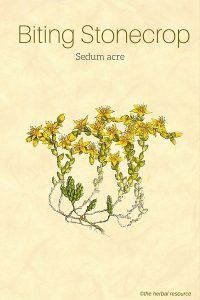The plant contains tannins, rutin (citrus flavonoid glycoside), several alkaloids, sedinon and sedridin and several organic acids.
Animal studies have shown that some alkaloids can have major toxicological effects. The amount of alkaloid is significantly reduced when the plant is dried.
Biting stonecrop has never been considered to play a big role in herbal medicine and even ancient literature warned against ingestion of the plant. It was, however, in the sixteenth century used as an ingredient in some remedies against intestinal parasites.
In 1830 it was mentioned as a possible cure for epilepsy but was rarely used for that purpose because of the plants irritating properties and harmful effects.
In traditional herbal medicine, the plant has often been regarded to have diuretic and laxative properties.
Additionally, it was used as an herbal remedy for diphtheria, ringworm, to trigger abortion, and also scurvy due to the high content of vitamin found in the plant.
The herb is known to be helpful to lower high blood pressure, but it should not be used as a blood pressure medicine.
When sedum acre is used topically the plant extract can work as a local anesthetic and increase blood flow to the skin.
The herb has been used to treat itchy rashes, ulcers and for the topical treatment of warts, pimples, acne dermatitis and corns.
The alleged herb’s ability to remove warts and corns has not been scientifically proven.
In homeopathy a tincture made from the fresh plant is used to treat hemorrhoids.
[Read more about Biting Stonecrop…]

Leave a Reply